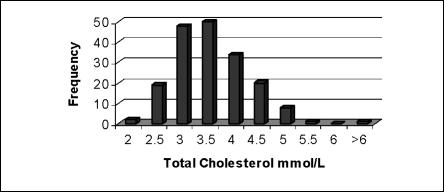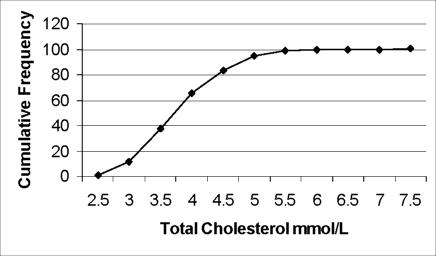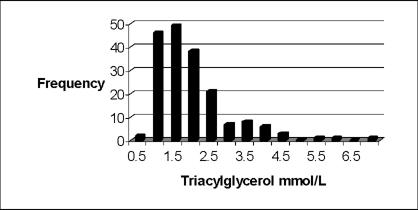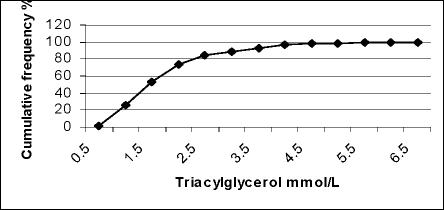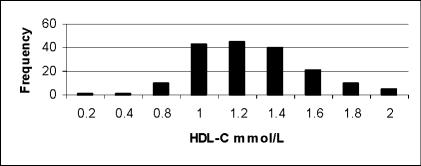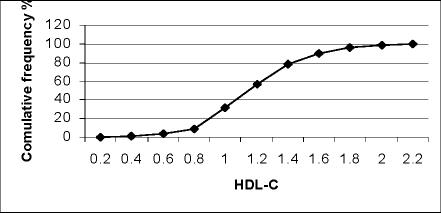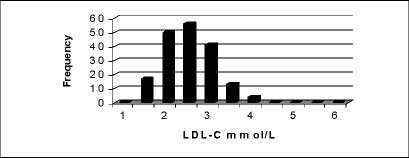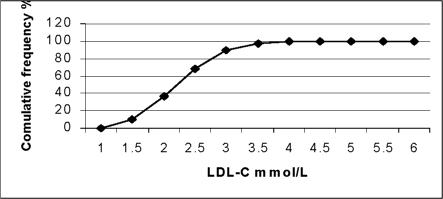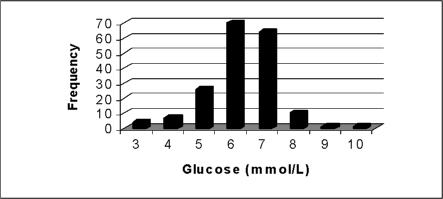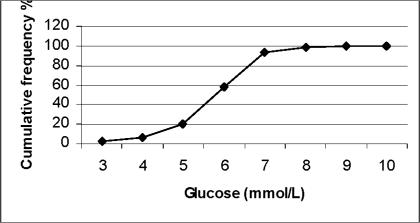Abstract
The purpose of this study was to establish blood glucose and lipid profile of Makerere University undergraduate students.
Study design
This was a cross-sectional study.
Materials and methods
A total of 183 students participated in the study. Capillary blood glucose was read instantly on a finger prick sample off Sensore™ glucose analyzer. Venous blood from the antecubital vein was used for lipid assays. Total cholesterol was assayed by the oxidase-peroxidase enzyme system. Plasma triacylglycerols were analyzed using the glycerokinase-oxidase reagents. HDL and LDL cholesterol were analyzed using homogeneous enzymatic methods. Concentration results for each variable were plotted in histograms and the type of distribution established. Summary statistics were then calculated non- parametrically to set reference values.
Results
Empirical ranges were: Cholesterol 2.1–7.2 mmol/L; triacylglycerols 0.4–6.87 mmol/L; HDLC 0.09–2.13 mmol/L; LDLC 0.95–5.38 mmol/L and capillary blood glucose 2.72–9.21 mmol/L. The reference ranges covering the central 95 percentile were: Cholesterol 2.65–5.15 mmol/L, triacylglycerols 0.61–4.03 mmol/L; HDLC 0.58–1.97 mmol/L; LDLC 1.25–3.57 mmol/L and capillary blood glucose 3.11–7.55 mmol/L.
Conclusion
The established reference values for the age group 20–26 years were: Total Cholesterol 2.65–5.15 mmol/L, LDL 1.25–3.57 mmol/L, HDL 0.58–1.97 mmol/L, TG 0.61–4.03 mmol/L and capillary blood glucose 3.11–7.55 mmol/L which differed from set international values.
Recommendations
We recommend the establishment of indices for the indigenous populations, conscientiously planned diets, and regular exercise.
Introduction
Abnormally high concentrations of fat and sugar in blood coupled with inactivity and obesity pause significant risk factors to the rapid development of atherosclerosis and premature heart disease1.
The World Health Organization and NCEP recommend blood lipid and glucose concentration shown in table 1 below.
Table 1.
| Classification | Total cholesterol |
LDL cholesterol |
HDL cholesterol |
Triglycerides (mmol/l) |
Glucose (mmol/l) |
| Desirable | <5.17 | <3.36 | >1.55 | <2.26 | <6.11 |
| Borderline | 5.17–6.18 | 3.36–4.11 | 0.91–1.53 | 2.26–4.50 | 6.11–6.94 |
| High | >6.21 | >4.41 | ---- | >4.50 | >6.94 |
| Low | ---- | ---- | <0.91 | ---- | ---- |
Cardiovascular diseases and diabetes mellitus are rapidly emerging as major causes of morbidity and mortality in Uganda 4,5,6. In a previous study7, public servants, who were mainly university graduates, were found to have abnormally high levels of plasma lipids.
The objective of this study was to analyze the baseline levels of blood lipids and glucose in a healthy population of young adults from university students in an attempt to set up reference values for total cholesterol, triacylglycerols, HDL- cholesterol and glucose in the population and to compare these with the internationally recommended ranges
Materials and Methods
Study site
Blood taking for glucose and lipid analysis was done in the halls of residence at the main campus of Makerere University, in Kampala, Uganda.
Study population
The study involved both male and female consenting students, aged between 20 to 26 years, in the nine halls of residence. The inclusion criteria were: healthy-looking, non-pregnant females and undergraduate studentship.
Procedures
Questionnaire
The participants were given self-administered questionnaires to provide information on demographic, lifestyle and health characteristics.
Blood Glucose measurements
Capillary glucose was read instantly on a finger prick sample off Sensorex™ glucose analyzer according to instruction manual.8
Plasma Preparation for Lipid Assays
Venous blood from antecubital vein was collected into heparin tube and taken to Kololo Polyclinic laboratory for centrifugation, storage and analysis.
Analysis
Total cholesterol was assayed by oxidase-peroxidase, phenol amino antipyrine, reagents of ThermoClinical Labsystems9 on Kenolab ™ chemistry analyzer.10
-
Triacylglycerols
The plasma triacylglycerols were analyzed enzymatically using lipase, glycerokinase, glycerophosphate oxidase and chlorophenol11 of Thermo Clinical Labsystems 12 on Kenolab™ chemistry analyzer.
-
HDL cholesterol
The HDL cholesterol was analyzed using homogeneous enzymatic calorimetric test reagents of ThermoClinical Laboratory Systems in which in the presence of magnesium sulfate, dextran sulfate selectively forms water soluble complexes with LDL, VLDL and chylomicrons which are resistant to polyethylene glycol (PEG) modified enzymes13. The concentration of HDL cholesterol was then determined enzymatically by cholesterol oxidase coupled with PEG on Kenolab ™ chemistry analyzer.
-
LDL- cholesterol
The LDL- cholesterol was assayed by a homogenous enzymatic colorimetric test in which in the presence of magnesium ions a sugar compound markedly reduces the enzymatic reaction for the cholesterol measurement in VLDL and chylomicrons. The combination of a sugar compound with detergent enables the selective determination of LDL- cholesterol in plasma using cholesterol esterase, cholesterol oxidase, 4- amino antipyrine, hydroxysulfopropyl dimethoxyanaline and peroxidase of Thermo Clinical labsystems on Kenolab ™ chemistry analyzer.
Data analysis
The concentration results in mmol/L of TC, TG, HDL, LDL and Glucose were each plotted in histograms to establish the type of distribution. Then summary statistics were calculated non- parametrically15.
Results
One hundred and eighty three students, 120 males and 63 females participated in the study. The age ranged from 20 to 26 years.
Total cholesterol
Empirically cholesterol concentration ranged from 2.1 to 7.2 mmol/L with a near Gaussian but slightly positively skewed distribution as shown in Figure IA.
Fig. 1A.
Total cholesterol concentration in Makerere University under graduates
The reference ranges covering the central 95 percentile was found to be from 2.65–5.15 mmol/L as determined from the cumulative frequency percentage curve of Figure 1B.
Fig. 1B.
Cumulative distribution of total choleterol in Makerere University undergraduates
The reference range of up to 5.15 mmol/L is within the reference range internationally recommended in table 1.
Triacylglycerols
The concentration of triacylglycerols in mmol/L ranged from 0.4 to 6.87mmol/L with a typically positively skewed distribution shown in Fig. 2A.
Fig. 2A.
Distribution of Triacylglycerols in Makerere University undergraduates
The reference range covering the central 95th percentile is read off the cumulative frequency percentage curve in Fig. 2B as 0.61–4.03 mmo/L.
Fig. 2B.
Cumulative distribution percentage of Triacylglycerols in Makerere University undergraduates
The triacylglycerols reference range of 0.61–4.03 mmol/L cuts across the desirable borderline and high ranges of international classification of table 1.
HDL Cholesterol
The HDL cholesterol concentration empirically ranged from 0.09 to 2.13 mmol/L making a near -Gaussian distribution curve as shown in Fig. 3A.
Fig. 3A.
HDL cholesterol concentration in Makerere University undergraduate students
The central 95th percentile range is from 0.58 to 1.97 mmol/L as read off the cumulative percentage curve in Fig. 3B.
Fig. 3B.
Cumulative distribution of HDL cholesterol concentration in Makerere University undergraduate students
This range includes the undesirable low range of HDL less than 0.91 mmol/L given in table 1.
LDL Cholesterol
The LDL cholesterol concentration empirically ranged from 0.95 to 5.38 mmol/L. The frequency distribution makes a near-Gaussian distribution shown in Fig. 4A.
Fig. 4A.
LDL cholesterol distribution in Makerere University undergraduate students
The cumulative percentage curve gives the central 95th percentile of 1.25–3.57 mmol/L shown in Fig. 4B.
Fig. 4B.
LDL cholesterol cumulative frequency in Makerere University undergraduate students
This range includes a portion of 3.36 – 4.11 borderline range of international reference values shown in table 1.
Capillary Glucose
The capillary blood glucose empirically ranged from 2.72 to 9.21mmol/L with a near Gaussian but negatively skewed distribution shown in Fig 5A.
Fig. 5A.
Glucose distribution in Makerere University undergraduate students
Alarmingly only 21% of the students have desirable HDL-C and a hefty 78% have borderline or low levels of HDL cholesterol. This low level of HDL-C in presence of low TC level is a serious indicator of physical inactivity and sedentarism.
Discussion
The incidence of obesity and non communicable diseases is up world wide and increasing urbanization and technological changes are the main catalyst for this remarkable rapid and decidedly dangerous rise in which major culprits of shift in diet and physical inactivity can be traced to higher income16. As shown previously urban public service employs in Kampala who are mainly university graduates of relatively high income, showed abnormally high levels of plasma lipids7 which predispose to CVD and diabetes that are rapidly on the rise in Uganda 5,6. It was therefore pertinent to set baseline levels of blood lipids and glucose in a healthy population of young adults from university students in an attempt to set reference values which would be compared with international recommended ranges.
The cumulative percentage shown in Fig 5B gives the central 95 percentile range of 3.11–7.55 mmol/L.
Fig. 5B.
Glucose cumulative distribution among Makerere University undergraduate students
In general, a TC value of over 5.17 mmol/L may indicate a greater risk for heart disease. However, LDL-C levels are better predictors of heart disease and determine how one's high cholesterol should be treated17 In this study the university undergraduate students have reference range of TC and LDL-C of 2.65–5.15 and 1.25–3.57 mmol/L respectively. These ranges are very close to the international recommended ranges in which (TC) 94% and (LDL-C) 90% of the students fall.
These students should be encouraged to maintain that level of cholesterol.
Evidence now suggests that TG may be a major trouble maker for the heart as TG appear to interact with HDL in such a way that HDL levels fall as TG levels rise meaning that high levels of TG and low levels of HDL are bad for the heart18.
This work shows 25% of the students have borderline-to-high levels of TG as 78% have borderline-to-low levels of HDL (Table 2). These students should be encouraged to reduce their TG and to increase their HDL by exercising regulary17.
Table 2.
Percentage Distribution of undergraduate students into categories
| TC | LDL-C | TG | Glu | HDL-C | |
| Desirable | 9.53 | 90.16 | 73.77 | 58.47 | 21.31 |
| Borderline | 4.91 | 9.29 | 24.59 | 34.97 | 46.45 |
| High | 0.56 | 0.55 | 1.64 | 6.56 | - |
| Low | - | - | - | - | 32.24 |
The glucose results obtained in this work shows that 42% of the students have undesirable levels of blood glucose. The high levels of TG, low levels of HDL and high levels of blood glucose point to the recently described atherogenic phenotype in which there is a high risk of CHD without raised levels of TC18,19. Besides, high levels of TG, low levels of HDL and high levels of glucose are also a surrogate measure of insulin resistance which is a treatable precursor of diabetes and potentially of cardiovascualr disease as well20. These students would be advised to reduce on their sedentarism and accumulate at least 30 minutes of moderate intensity physical activity most or preferably, all days of the week21.
Conclusion
From the study, baseline reference values were established based on the 95 percentile range for Makerere University undergraduate students in the age group 20–26 years. These were: Total Cholesterol 2.65–5.15 mmol/L, LDLC 1.25–3.57 mmol/L, HDLC 0.58–1.97 mmol/L, TG 0.61–4.03 mmol/L and Plasma Glucose 3.11–7.55mmol/L.
Recommendations
It is becoming increasingly clear that indices need to be established for the indigenous population because they depend upon factors of genetics, environment and lifestyle which vary from country to country.
This approach should also be widened in scope to embrace other statistics and anthropometric measurements, for example, for clothing and other personal utilities like shoes.
From the study findings, it also seems that the university students' diet is healthy. They should be educated on the significance of the study findings in relation to their continued health and encouraged to live healthy lifestyles and stick to habits that predispose to a low risk for cardiovascular illness. This includes regular exercise.
Acknowledgements
The authors strongly acknowledge financial support from SIDA/SAREC Uganda.
References
- 1.Lipid and Glucose profiles. Department of Science and Technology, 2002, Food and Research Institute, Bicutan, Tanguig, Metro Manila, Philippines. Email: mvc@fnri.dost.gov.ph.
- 2.WHO Technical Report #727. 1985
- 3.National cholesterol education program expert panel on detection, evaluation and treatment of high blood cholesterol in adults (adult treatment panel III) JAMA. 2001;285:2486–2497. doi: 10.1001/jama.285.19.2486. [DOI] [PubMed] [Google Scholar]
- 4.Zirembuzi G. Heart Cases on the Rise, New Vision. 2004 Sep 6;:3. Sat. [Google Scholar]
- 5.Namome JR. MMed (Int Med) Makerere University; 2001. Aug, Prevalence of known risk factors for cardiovascular disease among hypertensive patients attending the hypertension clinic at Mulago Hospital; pp. 1–60. Dissertation. [Google Scholar]
- 6.Achadu C A. MMed (Int Med) Makerere University; 2002. Jun, The pattern of cardiac disease and aetiology of cardiac failure among patients attending Mulago Hospital Cardiac Clinic and medical wards; pp. 1–72. Dissertation. [Google Scholar]
- 7.Bimenya GS, Okot JK, Nangosa SA, Anguma H, Byarugaba W. Plasma cholesterol and related lipid levels of seemingly healthy urban public service employees in Kampala, Uganda. African Health Sciences. 2006;6(3):139–144. doi: 10.5555/afhs.2006.6.3.139. [DOI] [PMC free article] [PubMed] [Google Scholar]
- 8.Sensorex™ G Apex Biotechnical Corp. Email: info@apexbio.com.
- 9.Schetter G, Niisel E. Arbeitsmed. Socialmed. Praventivmed. Massnachmen zur Pravention der Arteriosklerose. 1975;10:25. [Google Scholar]
- 10.Konelab Chemistry Analyser, author. Konelab S A. Eragny Parc. BP 249 Corgy Pontoise 95615 France.
- 11.Fossati P, Rincipe L. Serum triglyceride determined colorimetrically with an enzyme that produces Hydrogen peroxide. Clin Chem. 1982;28:2077. [PubMed] [Google Scholar]
- 12.Thermo Clinical labsystems. ThermoClinical labsystems Oy Ratatsie 2, P.O.Box 100 01620 Vantaa_Finlande.
- 13.Sugiuchi H, Uji Y, Okabe H, Irie T, Uekema K, Kayahara N, Miyauchi K. Direct measurement of High Density Lipoprotein Cholesterol in Serum with polyethylene glycol modified enzymes and sulphated Ü-cyclodextin. Clinical Chemistry. 1995;41:717–723. [PubMed] [Google Scholar]
- 14.Rifai N, Werrick G R, McNamara J R, Belcher J D, Grinstead G F, Frantz Measurement of Low Density Lipo Protein Cholesterol in serum: a status report. Clinical Chemistry. 1992;38:150–160. [PubMed] [Google Scholar]
- 15.Dawson Beth, Trapp Robert G. Basic and Clinical Biostatistics. Lange Medical Books/ McGraw Hill; 2001. [Google Scholar]
- 16.Popkin M B. World wide obesity epidemic tied to urbanisation technological change. Global Health and Environment Monitor. 2003;11(1):1–3. [Google Scholar]
- 17. http://www.drugs.com/enc/high_blood_cholesterol_and triaglycerides.html
- 18. http://www.well-connected.com/report.cgi/000023_3.htm
- 19.Haddon Labib M H, Vallane D. The atherogenic lipoprotein phenotype and secondary prevention. : Undiagnosed and mistreated?. Proceedings of the ACB meeting; Focus; 12–16 May 1997; Birmingham UK. p. 29. [Google Scholar]
- 20.Stern S E, Williams K, Ferrannini E, DeFronzo R A, Borgadus C, Stern M P. Identification of individuals with insulin resistance using routine clinical measurements. Diabetes. 2005;54(2):333–339. doi: 10.2337/diabetes.54.2.333. [DOI] [PubMed] [Google Scholar]
- 21.Rao G. Insulin resistance syndrome. American Family Physician. 2001;63(6):1–7. [PubMed] [Google Scholar]



